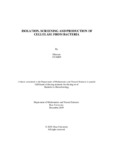| dc.contributor.advisor | Zaman, S M Rakib-Uz- | |
| dc.contributor.advisor | Hossain, Mahboob | |
| dc.contributor.author | Ebtesam | |
| dc.date.accessioned | 2021-03-08T04:27:32Z | |
| dc.date.available | 2021-03-08T04:27:32Z | |
| dc.date.copyright | 2019 | |
| dc.date.issued | 2019-12 | |
| dc.identifier.other | ID: 15136005 | |
| dc.identifier.uri | http://hdl.handle.net/10361/14322 | |
| dc.description | This thesis is submitted in partial fulfilment of the requirements for the degree of Bachelor of Science in Biotechnology, 2019. | en_US |
| dc.description | Catalogued from PDF version of thesis. | |
| dc.description | Includes bibliographical references (pages 40-47). | |
| dc.description.abstract | Cellulase finds uses as raw material in various industries. The current sources of cellulase are
highly expensive. However, using bacteria as cellulase producers can bring the cost down and
make our industries self-sufficient. This experiment was carried out bearing this thought in
mind. The experiment was started by culturing microorganisms obtained from various soil and
municipal samples on carboxymethylcellulose agar media. Colonies that showed clear zones
after being flooded with Gram's Iodine were further analysed to investigate their ability to
utilize filter paper as a carbon source. Postive samples were selected for enzyme production.
Biochemical analysis was used to characterize the bacterial isolates. The results indicated a
possibility of the isolates being Pseudomonas fluorescens biovar and Streptococcus sp.
Bacteria were cultured in carboxymethylcellulose broth. The cultured broth was then
centrifuged and the supernatant was used as crude enzyme. The enzyme activity was tested
using DNS assay to check glucose liberation after the degradation of cellulosic bonds.. Protein
concentration was estimated to be 0.09 mg/mL after performing Biuret’s Assay. Enzyme
production was then optimized using a range of temperature, time, pH and carbon source.
Cellulase produced from the synergistic effect of the obtained microorganisms was found to be
almost five times more potent than the enzymes produced by them separately.
The enzyme activity was noted as 0.175 U/mL, whereas, the specific enzyme activity was
found to be 1.82 U/mL. Thus, there was a tenfold increase in the value which indicates that
the enzyme activity would be increased at least ten times upon concentration and purification
of the enzyme. | en_US |
| dc.description.statementofresponsibility | Ebtesam | |
| dc.format.extent | 57 pages | |
| dc.language.iso | en_US | en_US |
| dc.publisher | Brac University | |
| dc.rights | Brac University theses are protected by copyright. They may be viewed from this source for any purpose, but reproduction or distribution in any format is prohibited without written permission. | |
| dc.subject | Cellulolytic bacteria | en_US |
| dc.subject | Cellulase | en_US |
| dc.subject | Enzymatic Activity | en_US |
| dc.subject | Protein purification | en_US |
| dc.title | Isolation, screening and production of cellulase from Bacteria | en_US |
| dc.type | Thesis | en_US |
| dc.contributor.department | Department of Mathematics and Natural Sciences, Brac University | |
| dc.description.degree | B. Biotechnology | |

